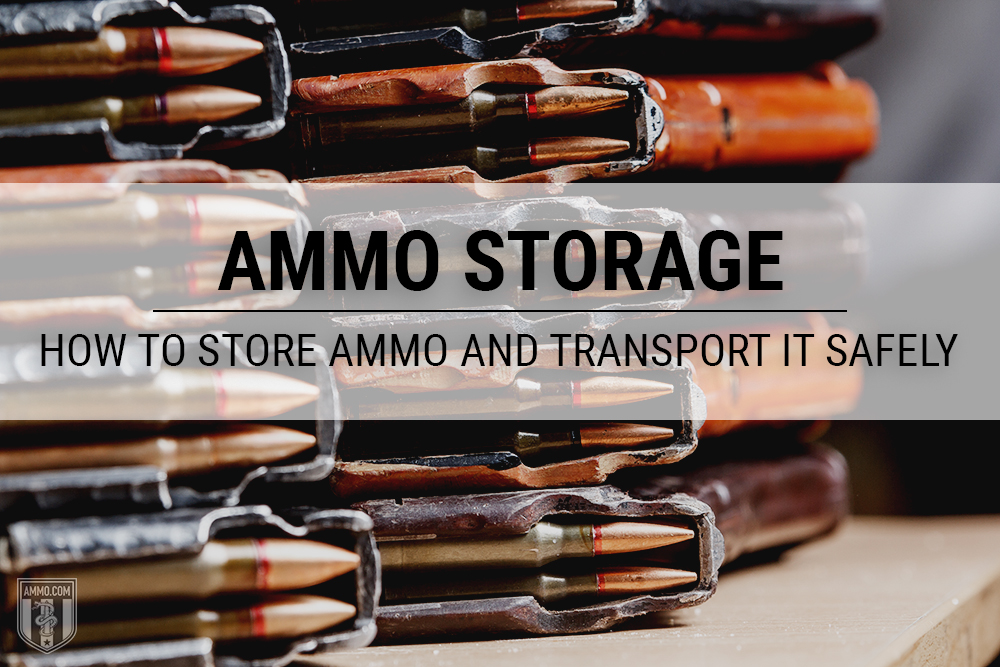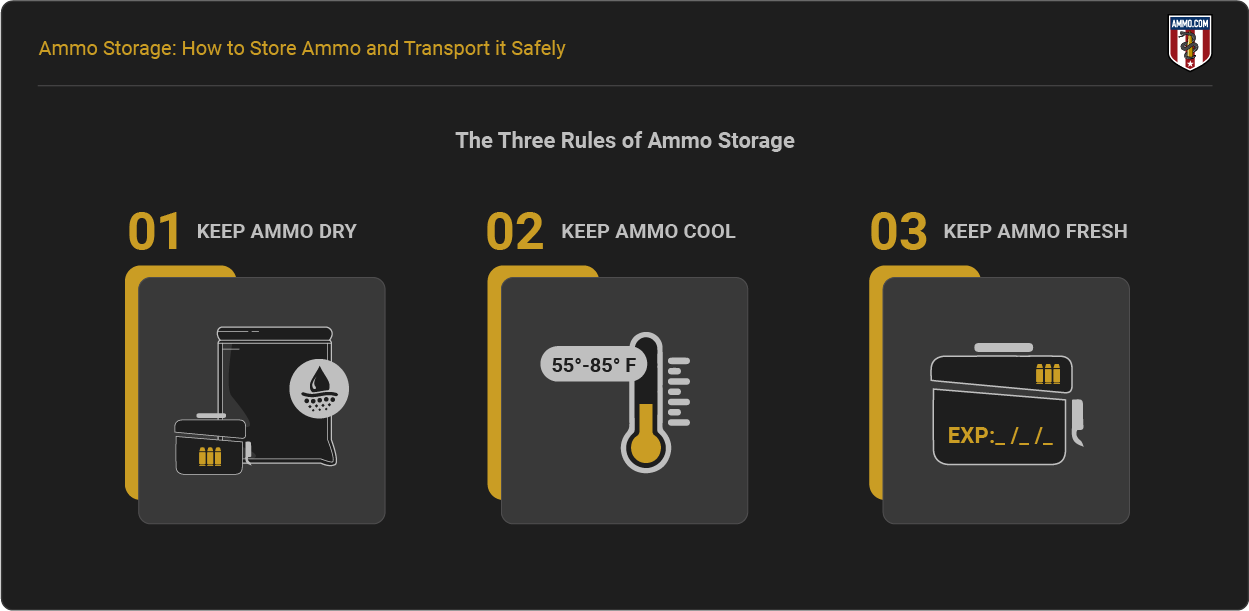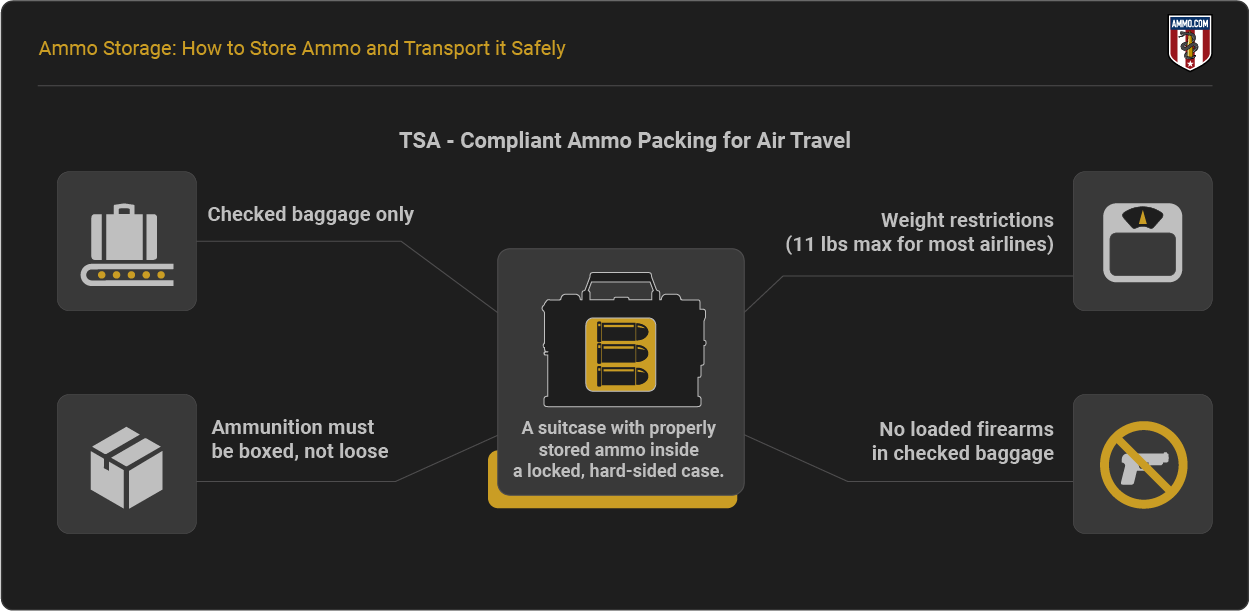Ammo Storage: How to Store Ammo and Transport it Safely
You're free to republish or share any of our articles (either in part or in full), which are licensed under a Creative Commons Attribution 4.0 International License. Our only requirement is that you give Ammo.com appropriate credit by linking to the original article. Spread the word; knowledge is power!

Properly storing and transporting your ammunition is essential to extending its lifespan and ensuring compliance with local, state, and federal laws. Handling your ammo correctly can prevent deterioration; obeying the law can prevent prosecution, incarceration and fines.
This guide discusses ways to improve the longevity of your ammo, as well as the safest (and legal) ways to store and transport it.
Ammo.com provides accurate and reliable information about firearms and ammunition. You can view the sources used in this article HERE.
Report Highlights: Ammo should be stored properly and can be transported if local and federal regulations are followed.
Maximize the longevity of ammunition by storing it inside secure containers in cool, dry areas.
It is legal to travel with ammunition as long as you lawfully possess it and the state does not prohibit its quantity or type.
Ammunition should not be left in hot cars for prolonged periods.
The TSA regulates the type and amount of ammunition that can be transported on a plane, as well as the fashion in which it is contained. Local ordinances may also apply.
The Best Ways to Store Ammo for Longevity
Want to ensure a long shelf life for your ammunition investment? There are just three easy steps to making sure your ammo stays reliable.
Keep Ammo Dry
Moisture is kryptonite to ammunition. No matter where you live, there is moisture in the air. Fortunately, there are several ways you can keep your ammo dry. 1
- Ammo Cans: The military learned about moisture’s effects on ammo the hard way, which is why it developed ammo cans. Make sure your cans have rubber seals to ensure no moisture gets inside.
- Moisture-Absorbing Packs: Handy (and cheap!) silica gel desiccant packs should always be kept with your ammunition, regardless of whether it’s stored inside a can or a Ziploc bag.
- Environment: Humid spaces like laundry rooms and bathrooms are never good choices for ammo storage. Wherever you decide to keep your stockpile, store it high and dry – i.e. off the ground. Also, make certain never to store ammo in direct sunlight.
Store Ammo in Proper Temperatures
Temperatures below 55° and above 150° Fahrenheit can ruin ammunition. Passing exposure to extreme temperatures can cause damage in a narrow timeframe.
Temperatures between 55° and 85° F are recommended for keeping ammunition fresh. Leaving ammo in a car for one or two days in extreme temperatures is unlikely to cause damage, so don’t throw it away. 1
Keep Ammo Fresh
Avoid opening ammo cans or other storage containers to see what’s inside. Label them with a description of their contents. Including the date of purchase allows you to follow the “first in, first out” (FIFO) rule, thereby ensuring you always fire your oldest ammo.
Now that we know how to safely store ammunition, it’s time to learn the safest ways to travel with and transport it.

Transporting Ammunition by Car
It’s imperative that you understand local, state, and federal laws before transporting ammo by vehicle.
Is It Illegal to Have Ammo in a Car?
Note: The information in the following sections is intended to provide a simple guide to traveling and transporting ammunition. We at Ammo.com are not lawyers. Nothing in this article should be construed as legal advice. Please check local, state and federal regulations to ensure compliance with the law.
Under the Firearm Owners’ Protection Act (FOPA), those who are transporting firearms for lawful purposes are protected from local restrictions that may otherwise prohibit passage. According to the NRA-ILA:
“Notwithstanding any state or local law, a person is entitled to transport a firearm from any place where he or she may lawfully possess and carry such firearm to any other place where he or she may lawfully possess and carry it, if the firearm is unloaded and locked out of reach. [...] Travelers should be aware that some state and local governments treat this federal provision as an ‘affirmative defense’ that may only be raised after an arrest.”
Both unloaded firearms and ammunition must be stored in the trunk or a locked container, but never in the glove compartment or console.
If you are traveling through areas with restrictive laws surrounding the transportation of ammunition and/or firearms, be sure to have copies of all relevant licenses and permits on hand. It also doesn’t hurt to have print-outs of any documents that feature relevant provisions of law, including FOPA.
Transporting Ammo Across State Lines
Although federal law permits traveling across state lines with ammunition, some states and municipalities have prohibitions on magazines; specifically with regard to their type, capacity and quantity. For example, traveling through New York State with a high-capacity magazine (i.e. one that holds more than 10 rounds) could land you one year in prison.
It is wise to consult a state’s local law enforcement or the attorney general’s office before transporting guns, magazines or ammo through it. Ensure that all ammunition is inaccessible to individuals in the vehicle while driving to or through another state (FOPA only covers firearms and ammunition). Furthermore, don’t travel with any parts, ammo, or firearms that are banned or prohibited in that state.
Is Ammo Safe in a Hot Car?
Storing cartridges in a hot car won’t cause them to explode or expel their bullets. Ammo doesn’t become volatile until ambient temperature reaches 400 °F, meaning you are safe so long as you don’t park your vehicle on the surface of the sun.
Prolonged exposure to heat can gradually degrade ammo, though. Primers and propellant may break down if exposed to unfavorable temperatures for too long, thereby increasing the likelihood of failures-to-fire (FTFs). 1
Flying With Ammunition
It’s important to remember what is prohibited from carry-on luggage while traveling aboard a commercial aircraft. Firearms, ammunition, and firearm parts must be properly stored inside checked baggage. While some law enforcement officers are permitted to fly armed, civilians are required to obey a strict set of rules. 3
Federal regulation states:
“Small arms ammunition for personal use carried by a crewmember or passenger in checked baggage only, if securely packed in boxes or other packagings specifically designed to carry small amounts of ammunition. Ammunition clips and magazines must also be securely boxed.”
7 Rules for Transporting Ammo by Air
With all of the TSA rules and regulations in place, flying with ammunition can feel overwhelming. Here are some quick reminders to help make the process easy and stress-free:
- Ammunition must be transported in checked baggage only.
- Ammunition must not exceed .75 caliber; shotgun shells of any size are permitted.
- Firearm magazines, ammunition clips, and speed loaders can be loaded or empty but must be securely covered where the ammunition is exposed using a metal, plastic, or cardboard sleeve.
- Ammunition must be securely packed (not loose) in a hard-sided case made of fiber, wood, metal, any packages designed to store ammo, or original packaging.
- While the DOT places no limitations on the number of packages or weight of ammunition transported, it does require the ammo to be for personal use only. Many carriers limit the weight of ammunition to 11 pounds (the international standard). Check with your airline before leaving for the airport.
- You can pack non-hazardous ammo components, including empty cartridges and inert bullets, in your carry-on luggage. Hazardous components, including black powder, smokeless propellant, percussion caps, and primers, must be checked.
- Firearms inside checked baggage cannot be loaded under any circumstances.

Before traveling, always check the laws concerning possession of firearms, as they vary by local, state, and international government. Also remember to check with your airline regarding any additional rules and restrictions it may have.
Wrap-Up
If you’re among the prepared shooters who have amassed a stockpile of ammunition, then you’re already ahead of the game. Be even more prepared by knowing the proper ways to store, maintain, and transport it. You can add decades to your investment’s lifespan – as well as avoid going to prison.
Sources
- SAAMI: Recommendations for Safe Ammunition Storage and Handling
- 18 U.S. Code § 926A: Interstate Transportation of Firearms
- TSA: Transporting Firearms and Ammunition
Preparedness
- Natural Disaster Survival Guide: Your Emergency Checklist
- Emergency Food Supply And Storage: The Survival Guide
- How to Prepare For Flooding: A Guide to Flood Survival
- How to Prepare for a Hurricane: A Survival Guide for Tropical Disasters
- Wildfire Safety Tips: The Ultimate Guide to Heatwave Safety and Preparedness
- Earthquake Survival Guide: How to Prepare for and Survive an Earthquake
- How to Survive a Tsunami: An Expert Tsunami Survival Guide
- How to Survive If the Power Grid Goes Down: Power Grid Failure Preparedness Guide
- How to Prepare for a Tornado: The Definitive Safety Guide
- How to Survive a Terrorist Attack: Prepare, Plan, and Survive
- Living off the Grid? These 8 Essential Off Grid Living Tips Will Help
- Surviving in the Outdoors: An Emergency Guide
- Ammo Storage: How to Store Ammo and Transport it Safely
- Top 27 Online Resources for Survivalists and Preppers
- Cold Weather Preparedness: A Guide to Winter Weather Survival
- Wildcat Cartridges: A Guide to Wildcatting and Customized Rounds
- Get Paid $1,200 to Watch the 12 Best Prepper Movies as You Self-Quarantine to Avoid COVID-19
